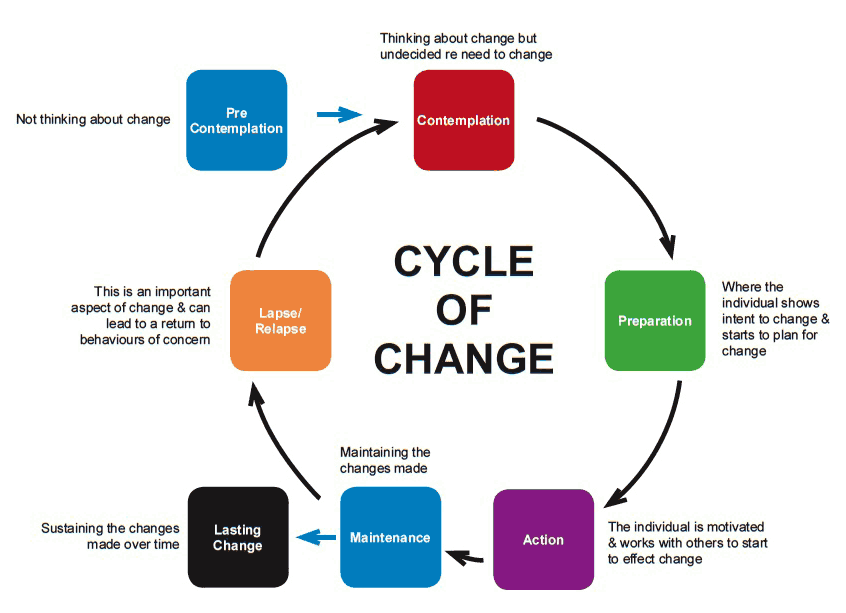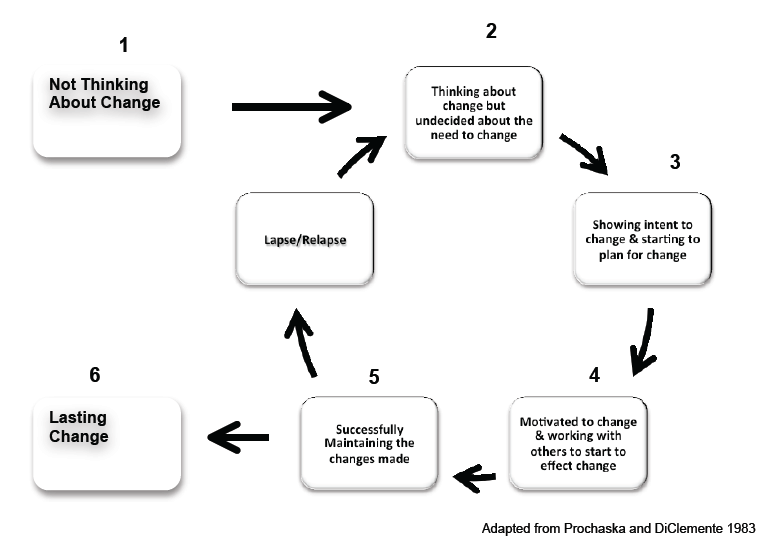National Risk Framework to Support the Assessment of Children and Young People
The document is a national risk assessment 'toolkit' for child protection to support practioners in identifying and acting on child protection risks in children and young people.
THE CYCLE OF CHANGE
Linked to motivational interviewing and relapse prevention work in addictions services, the Cycle of Change is a helpful tool in understanding and plotting a parent/carers potential for engagement with the risk identification, assessment and management processes. It also actively encourages consideration of particular aspects of resistance in parents/carers and assists understandings of issues such as those reflected where there is
- Denial that a problem exists
- Resistance to change
- A lack of commitment to making the agreed changes happen
- The parent/carers slip-back into their old behaviours when changes have previously been implemented
Used primarily in addictions services, the Cycle of Change can be applied to assist understanding of any change process.
The Cycle proposes two key principles:
- There are several stages a person must go through before they successfully action and maintain lasting change (a stage cannot be missed)
- Change is cyclical, people will have a range of feelings at different times about their risk behaviour/s and it can involve several attempts before they achieve any lasting change
The model is drawn up in various ways but is normally seen as having six stages set out as follows.
- Pre-contemplation
- Contemplation
- Preparation (sometimes called Decision or Determination)
- Action
- Maintenance (with an exit to termination or lasting change), and
- (Re)Lapse
The techniques to help move people from one stage to another are different depending on the current stage they are in. For example, offering solutions or seeking engagement in change processes when a person is in Pre-contemplation will not help whereas if they are in Determination this could be very productive. It is, therefore, very important to identify what stage a person is in when they are confronted with the need to change aspects of their behaviour, circumstances, lifestyles etc.
In Pre-Contemplation, the parent/carer has not thought about the need to change or does not acknowledge a problem exists. They are 'uninformed' in the sense that no personally convincing reason for change has been presented as yet.
In Contemplation, the parent/carer is ambivalent - they are in two minds about what they want to do. Sometimes they feel the need to change but not always.
In Action, the parent/carer is preparing and planning for change. When they are ready the decision to change is made and it becomes all consuming.
In Maintenance, the change has been integrated into the parents'/carers' life. Some support may still be needed through this stage. In Maintenance, lasting change is learned, practised and becomes possible. When we are able to maintain what we have achieved we exit the cycle entirely.
Lapse is a temporary return to 'old' unhelpful thoughts, feelings or behaviour.
Relapse is a full return to the old behaviour.
Lapse and Relapse are intrinsic to the Cycle Of Change and do not necessarily infer failure. It does not mean that lapse or relapse is desirable or even invariably expected. It simply means that change is difficult, not often a linear process and it is unreasonable to expect anyone to be able to modify behaviour perfectly without any slips. When Relapse occurs, several trips through the stages may be necessary to make lasting changes. Each time the person is encouraged to review, reflect and learn from their slips.
In child welfare there may be greater time and opportunity for working with parents/carers through the cycle of change. In a child protection scanario this will obviously be more boundaried by the character and severity of the risk (actual and potential) and time limited by the mandate to keep the child safe and protected.
Whilst the model is used widely to help with a range of behaviours, it is acknowledged questions about it remain. If simply viewed as an illustration of processes involved in change rather than as a defined pattern that fits everyone, it can though, help staff make better sense of the potentials for change, how to best shape practice interventions as well as the parent/carer's experiences of negotiating change.
Some Key Questions to Consider When Working for Individual Change
1. Is there a clear, shared understanding of concern by the service user/s?
2. Are they thinking about the need for change?
3. Whatfactors are present that support the potential for change and/or lapse/relapse?
4. Are they motivated to change?
5. Are there indicators of planning and action to support change?
6. Are they able and willing to work openly and honestly with services to address the identified concerns?
7. Are they motivated and positively engaged with others to secure change?
8. Is there Professional Confidence that engagement is genuine and sincere?
9. Is change being achieved, progress being made and improvement being
sustained by them?
10. If lapse/relapse, what factors were contributory?

Monitoring and Tracking Change

Example Means of Tracking Individual Change
This simple table allows practitioners to record, with the service user, their understandings of where they may be at in the change process at a particular point in time and to track progress and/or regression over time. Record number of current position, period allocated to obtain some progress and positive change in this, then record number for target position set and finally actual position reached after the review period agreed. The overall goal is to secure ability to maintain change over time but this can help highlight and track any trends or patterns in change efforts and provide useful evidence of the pace and type of progress being made.
| Date | Current Position | Period for Change | Target Position | Actual Position After Review Period |
|---|---|---|---|---|
| 29th Jul 2012 | 1 | 4 weeks | 2 | 2 |
| 27th Aug 2012 | 2 | 5 weeks | 3 | 3 |
| 4th Oct 2012 | 2 | 3 weeks | 4 | Lapse/Relapse |
| 21st Oct 2012 | Lapse/Relapse | 4 weeks | 3 | 3 |
Name: Signed:
Worker: Signed:
Contact
There is a problem
Thanks for your feedback